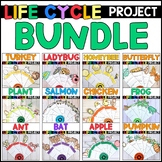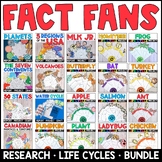Life Cycle of a Plant Project - Plant Research - Craft
- PDF
What educators are saying
Also included in
- Are your students ready to begin research projects on the life cycles of plants and animals? Are you looking for a rigorous yet engaging writing project that integrates science? These interactive projects allow students to research the life cycle of an apple, ant, bat, bee, butterfly, chicken, frogPrice $48.00Original Price $60.00Save $12.00
- Are you looking for engaging research projects for your students? Are you ready to study life cycles of animals and plants? Maybe some students are ready to jump in with both feet while others still need quite a bit of guidance. These no-prep interactive projects are just what you need to release rPrice $80.00Original Price $101.00Save $21.00
Description
Are you growing plants in your classroom? Ready for a plant life cycle project that is both rigorous and engaging? This Life Cycle of a Plant Project is the perfect supplement to your Plants science unit. Clear images are used to show seeds, germination, stems and roots, leaves, flowers, and pollination. The student uses the images as guidance as they research, take notes, write a report, and complete the plant craft. When complete, students have an interactive project that can be fanned in a circular shape to show the never-ending life cycle of flowering plants.
Included in the Plant Project download:
- recommended books and websites to get you started
- note taking sheets with writing prompts
- interactive fans for publishing
- vocabulary word wall cards
- complete answer keys
This project is ideal for:
- note taking practice
- introducing research
- for center work
- fast finishers
- independent projects
- as a supplement to your science unit on Plants
Students will:
- Take notes on each stage of the life cycle
- Transfer answers to fan pages
- Cut and paste labels onto fan pages
- Color the seed, germination, stems and roots, leaves, flowers, and pollination
- Cut out the fans
- Attach with a metal brad
See what teachers are saying!
❤️ "This is great! My students loved doing this activity. The sentence starters really helped them complete the activity independently." Mary M.
❤️ "This was a fantastic resource for my students who had become bored with my interactive notebook entries towards the end of the year. They really enjoyed this fact fan style, they even asked for more of them!" Courtney M.
Related Life Cycle Projects
⭐ Life Cycle of a Frog Project - Research Report - Frog Craft
⭐ Life Cycle of a Ladybug: Fact Fan Research Project
⭐ Life Cycle of an Ant Project - Research Report - Ant Craft







